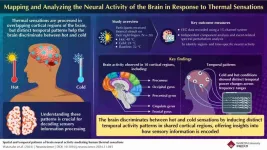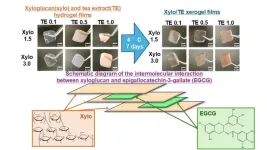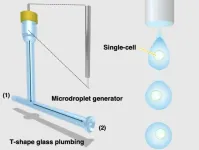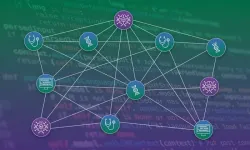(Press-News.org)
When we touch something hot or cold, the temperature is consciously sensed. Previous studies have shown that the cortex, the outermost layer of the brain, is responsible for thermal sensations. However, how the cortex determines whether something is hot or cold is not well understood. Thermal sensitivity is often subjective and individualistic; what is a comfortable temperature for someone might be too hot or too cold for someone else.
In a new study, Professor Kei Nagashima from the Body Temperature and Fluid Laboratory, Faculty of Human Sciences, Waseda University, Japan, and Dr. Hironori Watanabe from Waseda University, in collaboration with others, used electroencephalography (EEG) to map the brain’s response to hot and cold temperatures and clarify the activity patterns. In this study, 20 participants were exposed to different temperature treatments on their right index and middle fingers. The temperature treatments were given in pulses for 15 seconds with a 10-second intermittent temperature of 32 ˚C. Brain neural activity in response to the two different temperatures, 40 ˚C and 24 ˚C, was recorded using a wearable EEG device. The study was published in Volume 564 of Neuroscience on 09 January 2025.
The recordings were analyzed to reveal region- and time-specific patterns of brain activity. Clustered brain activity was found in ten different areas within the cortex. Interestingly, both hot and cold temperatures invoked brain activity in the same ten areas. However, the EEG differed in response to the two types of thermal sensation. “Differences in these activity patterns will allow temperature differences to be distinguished, leading to different behaviors,” says Nagashima.
Different types of activity patterns in the same brain regions could be the underlying mechanism for distinguishing between hot and cold temperatures. It was also observed that most of the brain activity was concentrated in the right hemisphere, indicating that it has a greater role to play in thermal sensations than the left hemisphere.
The insights obtained in this study could be applied to developing more objective methods to evaluate thermal comfort. Nagashima states, “Thermal comfort is used as a standard for creating an optimal indoor environment (air conditioning) by the American Society of Heating, Refrigerating, and Air-Conditioning Engineers, but it is still based on subjective reporting. We thought that it was essential to evaluate it objectively and scientifically.” Health risks due to the ambiguity of subjective evaluations of thermal comfort could be circumvented with a better understanding of the brain’s response.
***
Reference
Authors: Hironori Watanabea,b,c, Satoshi Shibuyad, Yuta Masudae, Taisuke Sugic, Kiyoshi Saitoa,f, and Kei Nagashimaa,c
DOI: 10.1016/j.neuroscience.2024.11.045
Affiliations: aInstitute for Energy and Environmental System, Sustainable Energy and Environmental Society Open Innovation Research Organization, Waseda University, Japan
bAdvanced Research Center for Human Sciences, Waseda University, Japan
cBody Temperature and Fluid Laboratory, Faculty of Human Sciences, Waseda University, Japan
dDepartment of Integrative Physiology, Kyorin University School of Medicine, Japan
eLaboratory of Animal Science, Graduate School of Life and Environmental Sciences, Kyoto Prefectural University, Japan
fDepartment of Applied Mechanics and Aerospace Engineering, School of Fundamental Science and Engineering, Waseda University, Japan
About Waseda University
Located in the heart of Tokyo, Waseda University is a leading private research university that has long been dedicated to academic excellence, innovative research, and civic engagement at both the local and global levels since 1882. The University has produced many changemakers in its history, including nine prime ministers and many leaders in business, science and technology, literature, sports, and film. Waseda has strong collaborations with overseas research institutions and is committed to advancing cutting-edge research and developing leaders who can contribute to the resolution of complex, global social issues. The University has set a target of achieving a zero-carbon campus by 2032, in line with the Sustainable Development Goals (SDGs) adopted by the United Nations in 2015. To learn more about Waseda University, visit https://www.waseda.jp/top/en
About Professor Kei Nagashima
Kei Nagashima is a Professor at the Faculty of Human Sciences at Waseda University, Japan. He received his medical degree in 1986 and Ph.D. in 1995 from the Kyoto Prefectural University of Medicine. His primary area of research is physiology with a focus on thermal regulation in humans and animals. He has over 100 publications and over 3,000 citations to his credit.
END
Green tea shines as a natural powerhouse of antioxidants, with catechins leading the charge among its polyphenols, which protect cells from oxidative stress. These powerful compounds neutralize harmful free radicals generated during cancer treatment. The anti-inflammatory properties of green tea can alleviate oral mucositis, a painful inflammation of the mouth lining often caused by chemotherapy and radiation.
Building on these benefits, researchers at the Tokyo University of Science (TUS), Japan, have explored the potential of tea catechins in developing ...
Trace metals are crucial for the growth of all living organisms. Understanding the role of these trace metals on the metabolism is essential for maintaining a stable state of the organism. Additionally, human beings are also facing constant exposure to various harmful heavy metals due to various types of pollution. Collectively, these aspects have led to research and development in the field of analytical techniques that can help in identifying the level of these trace metals in our cells.
Inductively coupled ...
Large language models (LLMs) have transformed how many of us work, from supporting content creation and coding to improving search engines. However, the lack of transparency, reproducibility, and customisation of LLMs remains a challenge that restricts their widespread use in biomedical research.
For biomedical researchers, optimising LLMs for a specific research question can be daunting, because it requires programming skills and machine learning expertise. Such barriers have reduced the adoption of LLMs for many research tasks, including data extraction and analysis.
A new publication in Nature Biotechnology introduces BioChatter to help overcome ...
The findings, published today in Scientific Reports, show, for the first time, how porous ground treatments can mitigate noise and optimise propellor performance.
Lead author Dr Hasan Kamliya Jawahar from the University of Bristol’s aeroacoustic group managed by Professor Mahdi Azarpeyvand was able to demonstrate that porous ground treatments, can significantly reduce noise by up to 30 dB in low-mid frequencies and enhance thrust and power coefficients compared to solid ground surfaces. This suggests that treating roofs of building, ...
A newly established research hub in North East England will explore the extent and environmental impact of microfibre loss from textiles.
Microfibre shedding from clothing during machine washing and drying is well known, with the tiny fibres causing harm to wildlife and the environment when they enter soil, air and waterways.
Located on Northumbria University’s campus in the centre of Newcastle, the Fibre-fragmentation and Environment Research Hub (FibER Hub) is the result of a collaboration between the University and The Microfibre Consortium (TMC) and will extensively test a wide variety ...
Is there only one optimal configuration an organism can reach during evolution? Is there a single formula that describes the trajectory towards the optimum? And can we ‘derive’ it in a purely theoretical fashion? A team of researchers, including from the Institute of Science and Technology Austria (ISTA), has answers. Their mathematical model forecasts the ideal body plan of a fruit fly’s early embryo, suggesting that evolution might had many optimal options at its disposal.
It is hypothesized that optimization is the secret sauce for many of nature’s fascinating ...
As their traditional dining options dwindle and natural areas give way to restaurants, homes and sidewalks, the coyotes of San Francisco are shifting what they eat.
Scientists from the University of California, Davis, wanted to understand what San Francisco’s coyotes are eating, and how their diet is changed and shaped by the city’s landscape, which can vary from block to block.
Their study, published in the journal Ecosphere, found that the number of restaurants and amount of pavement or “impervious surfaces” within the city heavily influenced what the coyotes ...
Glucagon-like peptide 1 receptor agonists (GLP1RA)—medications for type 2 diabetes and obesity that have recently been making headlines due to a rise in popularity as weight loss agents—have been linked with behavioral side effects. A large population-based analysis in Diabetes, Obesity and Metabolism assessed whether certain genetic variants might help explain these effects.
GLP1RA mimic the GLP-1 hormone in the body that helps control insulin and blood glucose levels and promotes feelings of satiety. GLP-1 ...
Many companies are making substantial investments in artificial intelligence (AI), which can enhance decision-making processes, foster innovation, increase productivity, and have other advantages. New research published in the Journal of Management Studies shows that company employees’ perceptions of how well AI performs (cognitive trust) and feelings towards AI (emotional trust) vary, and that these perceptions can affect AI performance and adoption in organizations.
Interviews with employees of a medium-sized software development firm revealed four different ...
Sleepiness at the wheel is a significant contributing factor to motor vehicle accidents. A new analysis published in Otolaryngology–Head and Neck Surgery reveals that for people with sleep apnea, getting surgery for their condition may lessen their risk of such accidents compared with using a Continuous Positive Airway Pressure (CPAP) device at night or receiving no treatment.
In the analysis of data on 2,832,437 patients with obstructive sleep apnea, 3.4% of patients who underwent surgery were in a car accident at any point following their diagnosis, compared with 6.1% of those using a CPAP and 4.7% of those not receiving any treatment.
Patients ...






